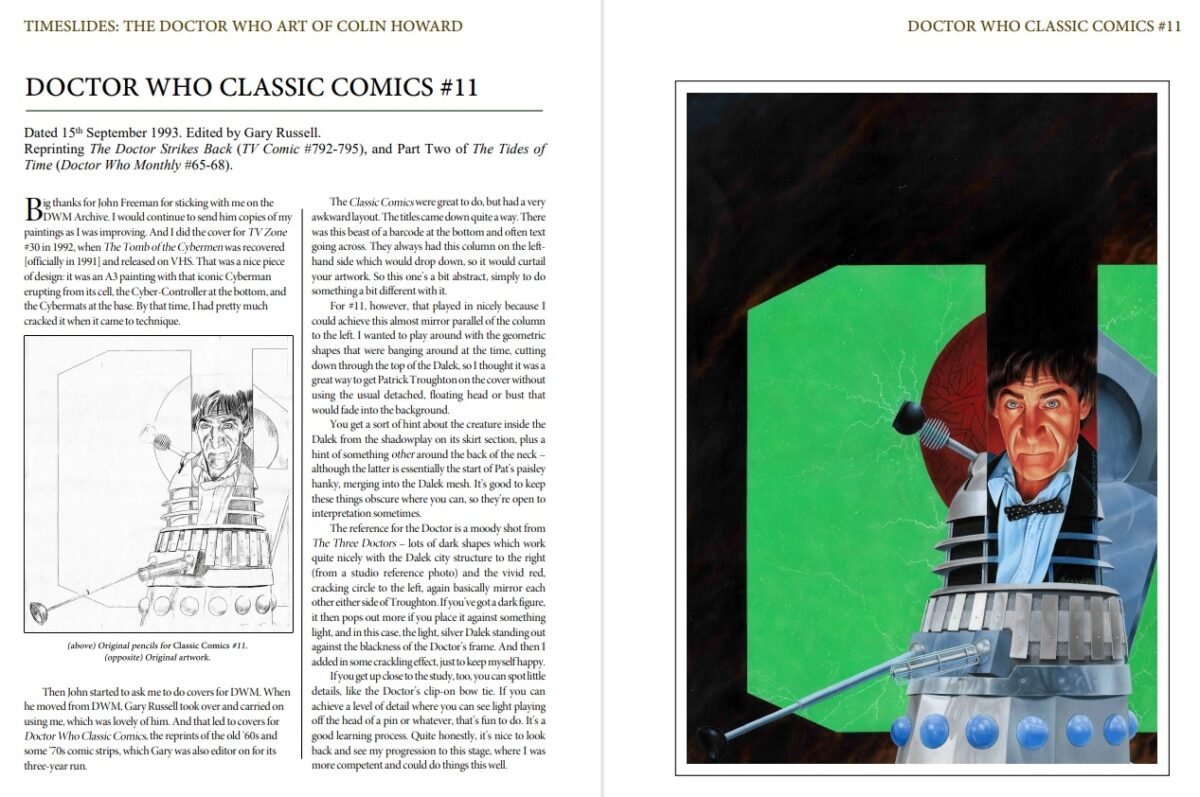Fans of Doctor Who art have been spoiled in recent months with new books collecting the works of artists Andrew Skilleter, Phil Bevan, and, in this new volume from Candy Jar, Colin Howard.
Colin is probably best known for producing cover artwork for Doctor Who books, magazines, and VHS releases, but his enthusiasm for the programme goes back much further. Born in 1965, he was an early collector of Target novels and would later join his local DWAS group. There’s an entertaining recollection of how he made his own Sontaran costume (sadly not pictured here) using papier-mâché for the head and bandaging his fingers together “to make the right gloves”, his efforts making the front page of the local newspaper.
He went on to supply art for various fanzines and, as he recounts in the opening chapter, flooded Doctor Who Magazine with submissions. Early commissions by editor John Freeman, who supplies an introduction to the book, for comic strips based on The Masque of Mandragora and Terror of the Autons set him on his way. In the 1990s, Colin became a regular provider of covers for Doctor Who VHS releases, and his artwork for these and other commissions are beautifully presented in full colour.
As well as a collection of artwork, the book serves as a history of what already feels like a distant, pre-internet era, where artwork had to be sent by post (with the accompanying risk of not reaching its destination) and artists like Colin had to compile their own personal index of hard-copy images to use for likenesses of actors and monsters. He manages to maintain a positive outlook for the most part, but feels justifiably sad that the VHS range cover art “has mostly been lost to time”.

Indeed, the lot of the cover artist is often not a happy one, as demonstrated by Colin’s memories of working to very tight deadlines, seeing his work cropped or obscured by logos and text, and having to respond to the whims of art directors and designers whose knowledge of Doctor Who was sketchy at best. An anecdote tells how, under pressure to make the series “appear space-oriented and full of action”, he struggled to come up with a suitable image for Paradise Towers, a story he fondly describes as “sort of like Doctor Who as a weekly sitcom”.
But his love for his craft endures and he’s clearly never happier than when he’s sketching, painting or developing a new piece. The book goes into some depth on his different techniques and will be of great interest to budding artists, but also those non-artists such as myself who look at a finished artwork and wonder just how someone starts with a blank canvas and ends up with that.
It feels incredibly cruel that someone who makes his living as an artist should be affected, as Colin is, by multiple sclerosis (MS), a condition which has slowly eroded his abilities. He’s clearly determined to carry on working, however, and now finds it easier to use a graphics tablet pen than a paint brush.
Colin’s wife Michelle writes movingly of how he has excelled in many different genres, recalling how he created a stunning portrait of a cheetah when they volunteered at a sanctuary in South Africa; their shared passion for the natural world shines through several times in the book.
It’s one of many personal tributes, with names from the Doctor Who world including Gary Russell, Rob Shearman, and Pete McTighe, as well as fellow artists such as Lee Sullivan, Martin Geraghty, and Lee Binding, recalling how Colin has inspired and supported them. There’s a foreword by Colin Baker, who provided a reference early in the artist’s career which helped get him taken seriously by potential employers. And there’s a lovely story about how, inspired by meeting Lis Sladen, he included her daughter Sadie’s name in the cover for The Monster of Peladon – and got to tell Sadie about it many years later.

The book brings us up to date by giving an insight into Colin’s recent contributions to the animated DVD and Blu-ray releases, an outlet that he’s enjoyed for its collaborative approach, even if the very specific requirements of recreating lost episodes don’t allow him to be as creative as he’d like.
Everyone will have their own favourites in a collection such as this one. My own include the vibrant VHS covers for Frontier in Space and The King’s Demons, and a striking private commission for Scream of the Shalka which portrays Richard E. Grant’s Doctor in a whole new light. Colin himself picks The Sea Devils VHS artwork as a personal highlight, one he has always declined to sell.
The book is edited by our own Philip Bates, editor of the DWC, who is developing an impressively varied portfolio of Doctor Who-based books (see also 100 Objects of Doctor Who and his Black Archive volume on The Pandorica Opens/The Big Bang). He has done an excellent job of bringing together Colin Howard’s extensive body of Doctor Who artworks and presenting a rounded portrait of the man himself. The book performs an important role in cataloguing a lost era of art connected to the programme, and will be a valuable addition to any fan’s collection.
Timeslides: The Doctor Who Artwork of Colin Howard can be ordered from Candy Jar in paperback and limited edition hardback.



